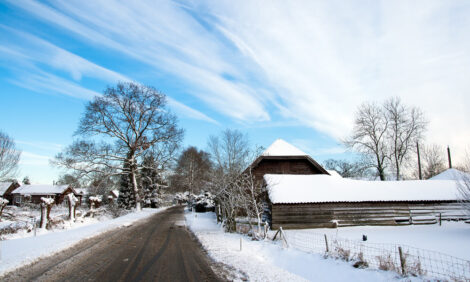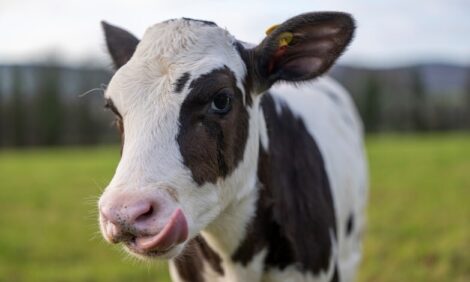



New Zealand Livestock And Products Semi-Annual Report 2010
The forecast for total cattle slaughter in 2010 was reduced by 4.8 per cent to 3.74 million head, according to the USDA Foreign Agricultural Service. Beef production is forecast to fall by just one per cent due to good pasture conditions and an expected increase in carcase weights. Domestic consumption is expected to be 120,00 tons for both 2009 and 2010. It is expected exports will drop 1.35 per cent.Executive Summary
Post reduced the forecast for total slaughter in MY 2010 by 4.8 per cent to 3.74 million head. This reflects an eight per cent decline in the cow slaughter forecast, a six per cent decline in the calf slaughter forecast, and a two per cent reduction in the other adult cattle slaughter forecast. Beef production is also forecast to fall but by just one per cent due to good pasture conditions and an expected increase in carcass weights.
Forecasts for domestic consumption are unchanged at 120,000 tons for both MY 2009 and MY 2010. Domestic beef consumption remains relatively static at approximately 27.14 kilograms per capita.
Post forecasts total exports for MY 2010 at 364,000T (PW) or 510,000T (CWE). This is a 1.35 per cent, or 7,000 ton (CWE) reduction from the previous update. Industry contacts expect shipments to the US market to be the same as in MY 2009 at 235,000T (CWE). Prevailing market conditions are largely the same as in late MY 2009 and other manufacturing beef markets are offering competitive prices for New Zealand product.
The first round of the TransPacific Partnership negotiations is set for March 2010. The New Zealand meat industry is advocating for the elimination of US tariffs. They maintain that New Zealand’s beef exports to the US are complimentary to US beef production because lean meat from New Zealand is blended with US fat trimmings to manufacture value-added products such as burgers, patties, and pizza toppings.
In January 2010, the New Zealand Government gave the go-ahead for the National Animal Identification and Tracing (NAIT) project, a livestock traceability scheme. Under the programme, the Government will provide funding to build and operate the new system and would draw up legislation to make it compulsory for cattle and deer farmers.
PRODUCTION
Pasture Conditions
- Plentiful rain during January and early February over most of the North Island has resulted in good pasture growth throughout the North Island, with the exception of Northland. With plenty of pasture available, farmers are holding stock back from slaughter, which will result in higher carcase weights.
- The outlook from February through April 2010 (late summery/early fall) is for good rainfall, especially in the eastern party of the country. However, the good pasture conditions mask an underlying trend toward decreasing utilisation of fertiliser. Fertiliser use peaked in 2002/03 at 170 kilograms/ha and is now down to 90 to 100 kilograms/ha. Fertiliser expenditure on a per hectare basis is virtually the same now as it was in 2002/03. Completely withholding fertiliser reduces total pasture growth by between 1 to 5 per cent per annum.

Slaughter
MY 2009
Total slaughter for MY 2009 was 3.85 million head, two per cent less than post’s forecast. Calf slaughter was down three per cent, largely because of the relatively low prices paid by meat processors, cow slaughter was down less than 1 per cent, and other adult cattle slaughter was down 2.4 per cent.
MY 2010
Post forecasts MY 2010 total slaughter at 3.74 million head, a 4.8 per cent reduction from the previous forecast. This reflects an eight per cent decline in the cow slaughter forecast, a six per cent decline in the calf slaughter forecast, and a two per cent reduction in the other adult cattle slaughter forecast. Factors supporting the downward adjustment include:
- Lower prices for veal and calf by-products;
- An increase in the milk price (NZ $6.00/kg milk solids compared to NZ $5.20 last year), which will encourage farmers to retain more dairy cows, especially as many dairy farmers were thought to be short of desired herd numbers last spring;
- an expected increase in beef heifer retentions and beef cow numbers due to improved pasture conditions and an uptick in farmer confidence;
- the ongoing trend to expand the dairy herd by approximately 100,000 head per year and the need for replacements suggests a lower cow kills; (Note: Given a total combined beef and dairy cow herd of 5.7 million head, with an average life expectancy in the herd of seven to eight years, post estimates that between 875,000 and 925,000 head are typically available for slaughter. However, the trend since 2000 has been for the dairy cow herd to increase by approximately 100,000 head each year and this trend is likely to continue this year. As the number of replacements retained is inadequate to support the increase in the dairy herd, the cow kill is likely to be reduced.)
- A decline in adult cattle slaughter during the fourth quarter when the lower retentions of the last few years will be felt. (Cattle slaughter will likely fall during the first quarter as producers take advantage of good pasture growth, however, an upturn is expected during the second quarter.)
Inventory
MY 2009
According to Statistics NZ, the ending inventory for MY 2009 was 9.917 million head of cattle, which is 1 per cent above post’s latest forecast.
MY 2010
- Post increased the total ending inventory forecast for MY 2010 to 10.09 million head, up nearly two per cent, or 186,000 head. The increase is attributable to:
- An expected 100,000 head increase in the cow herd;
- A likely increase in dairy heifer retentions to support the larger dairy herd; and,
- A 20,000 to 30,000 head increase in beef heifer retentions for beef cow replacements because of better pasture conditions and growing confidence in the future of beef breeding.
Beef Production
MY 2009
Post revised the beef production estimate for MY2009 downward by 10,000 tons, or 1.6 per cent, to 624,000 tons. This reflects reduced slaughter numbers in the fourth quarter, mainly from other adult cattle (steers, heifers, bulls) which were down 2.4 per cent or 37,000 head from the last update. The cold, wet spring was part of the reason for the reduced kill as it restricted cattle growth rates.
The reduction in beef herd numbers in MY 2009 is impacting on the number of cattle coming forward for slaughter in the current marketing year.
MY 2010
Post reduced the forecast for total beef production by 1 per cent to 619,000 tons. Factors contributing to the downward revision in the forecast include:
- Cow slaughter is now forecast at eight per cent below the previous estimate (but carcass weights will be up one per cent, or three kilograms/head, because of better pasture conditions.)
- The calf slaughter forecast has been revised downward six per cent to 1.46 million head because farm gate prices will not be high enough to encourage increased supply. It is anticipated that carcass weights will increase because the processors don't want to process lighter calves and farmers are likely to feed calves a day or two longer to make sure that what is sent to market is sufficient weight.
- While the adult other cattle slaughter forecast has been revised downward by two per cent, good pasture conditions are expected to influence cattle growth rates for the rest of the year. It is anticipated that carcass weights will be, on average, 10 kilograms heavier than the previous year bringing them more in line with carcase weights experienced in 2006 and 2007. While Post had anticipated an increase in carcass weights in the previous update, this is a further two per cent improvement on that previous forecast.

CONSUMPTION
Forecasts for domestic consumption are unchanged at 120,000 tons for both MY 2009 and MY 2010. According to Meat and Wool New Zealand, domestic beef consumption remains relatively static at approximately 27.14 kg per capita.
TRADE
MY 2009 Exports
Total New Zealand beef exports totaled 367,061 tons (product weight) or 514,000 tons (carcass weight equivalent) in MY 2009, which is 2 per cent, or 11,000 tons (CWE) less than post’s previous estimate. Fourth quarter slaughter rates were lower than anticipated, especially for steers, bulls and heifers.
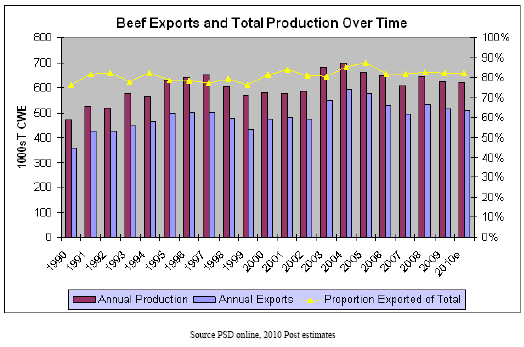
By the end of MY 2009, New Zealand had only shipped 167,546T (PW) to the United States as compared to the 186,000 tons previously forecasted. This is partly because the reduction in slaughter numbers had more of an effect on manufacturing beef production than other categories, and, during the 2nd half of the year, other markets began to emerge that were paying marginally higher returns including Indonesia, Malaysia, Hong Kong, the Middle East and Canada.
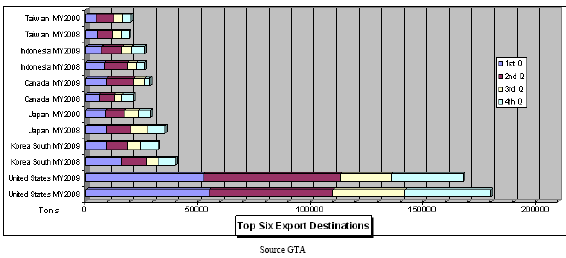
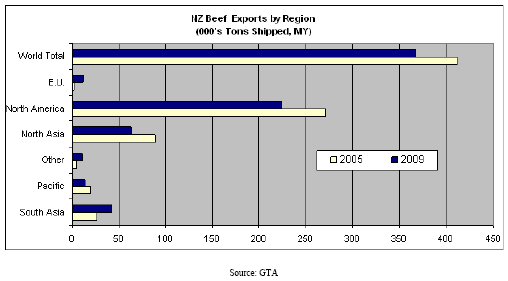
MY 2010 Exports
Post forecasts total exports for MY 2010 at 364,000T (PW) or 510,000T (CWE). This is a 1.35 per cent, or 7,000 ton (CWE) reduction from the previous update.
Industry contacts expect shipments to the US market to be the same as in MY 2009 at 235,000T (CWE). Prevailing market conditions are largely the same as in late MY 2009 and other manufacturing beef markets are offering competitive prices for New Zealand product. However, during the last five weeks, the US manufacturing beef price for 95 per cent chemical lean imported beef has increased by 13 per cent. Since the beginning of the year, it is up 22 per cent. This implies that exporters could start to divert product to the US market, but slaughter rates at the moment are so low that, even if as much product is shipped to the US as possible, it is unlikely to surpass MY 2009 levels. Some contacts report that the spike in US import prices could be short lived and, as soon as supply from Australia picks up and the winter woes affecting logistics of cattle in the US cease, then the US price will fall.
Generally, New Zealand exporters are bullish on beef prices, especially in view of the short supply of beef on the international market, which has become apparent over the last month or so. Rather than a blip, many exporters perceive this as a 12 to 18-month trend. Factors supporting this trend include:
- According to exporters, consumer demand is picking up but, in some markets, consumers are still concentrating their purchases on the lower end of the market (eg burgers);
- North Asian demand is solid and prices have firmed during January and February 2010;
- Middle Eastern and South East Asian markets are generally showing continued volume growth;
- The Russian market is beginning to open up, and while quantities shipped from New Zealand may be limited (MY 2008 3,830 tons shipped but in MY 2009 only 274 tons), the increased demand may have spin-off effects in other markets in terms of tighter supply and higher prices; and,
- Exporters are getting calls from niche markets in the EU and elsewhere.
Export Pricing
As demonstrated by the chart below, which features just one market segment, exchange rate volatility can either moderate market price movements at the farm gate or accentuate them. The last few weeks are a case in point. While US imported beef prices are at historical highs for this time of the year (23 per cent ahead of the five-year average), New Zealand farm gate prices are only 6 per cent ahead of the average. All other grades of beef are similarly impacted although perhaps not to the same extent as bull meat, which is very much a pure commodity product.
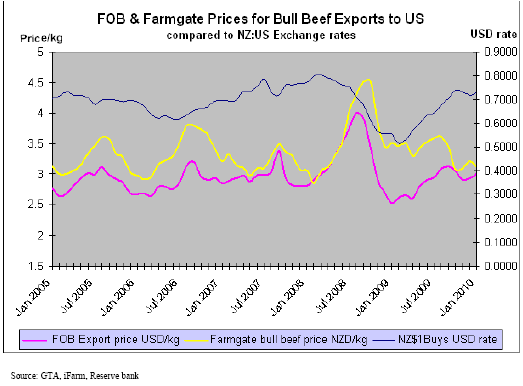
POLICY
Halal
The two New Zealand-based Halal certifiers were delisted by the Indonesian clerical authority early in 2009. The Indonesian clerical authority has set up its own certifying system and the New Zealand-based certifiers remain delisted for Indonesian audits. Under the new system, auditors are flown in from Indonesia several times a year to carry out audits on meat and milk processing facilities as required.
Malaysia FTA
The Malaysia –New Zealand Free Trade Agreement (FTA) was signed in Kuala Lumpur on October 26 2009. All beef products exported to Malaysia from New Zealand were already duty free so the effect on meat exports will be negligible. Additionally, because of the issues with Halal certification, only two beef production plants are registered to export to Malaysia. MY 2009 exports were 2,356 tons, as compared to zero in MY 2006 when all plants were de-registered. Before this, New Zealand exported approximately 7,000 tons per year to the Malaysian market.
Hong Kong-New Zealand Closer Economic Partnership
The New Zealand/Hong Kong, China Closer Economic Partnership (CEP) was concluded by officials on the margins of APEC and announced on November 13, 2009. Officials must complete legal verification of the agreement before it can be signed. This is likely to take place around March 2010). Details of the agreement will be made public at that time.
New Zealand-Gulf Cooperation Council (GCC) Free Trade Agreement
Negotiations on the New Zealand – Gulf Cooperation Council (GCC) Free Trade Agreement (FTA) successfully concluded on October 31, 2009 following six rounds of negotiations. Officials must now complete the legal verification process before the FTA can be signed. It is likely that the agreement will be signed in the first half of 2010.
TransPacific Partnership Agreement
The Obama Administration announced on November 14, 2009 that the United States will engage with the Trans-Pacific Partnership (TPP) countries “with the goal of shaping a regional agreement that will have broad-based membership and the high standards worthy of a 21st century trade agreement”. The first round of negotiations is set for March 2010. Meat and Wool NZ and the Meat Industry Association jointly made submissions to the Ministry of Foreign Affairs and Trade on the TPP. In summary, they would like to see the US tariff rate quota, which currently stands at US 4.4 cents/kg, be reduced to zero. They are also advocating elimination of the over-quota tariff rate, which is currently 26.4 per cent on fob value. They maintain that New Zealand’s beef exports to the US are complimentary to US beef production because lean meat from New Zealand is blended with US fat trimmings to manufacture value-added products such as burgers, patties, and pizza toppings. Meat and Wool New Zealand contends that New Zealand only supplies at most two per cent of total US consumption, and because of land constraints, is not going to be able to increase this. More information on TPP can be found at: http://www.mfat.govt.nz/downloads/trade-agreement/transpacific/Submissions-part-7.pdf
Further information on New Zealand’s FTA’s can be found at: http://www.mfat.govt.nz/Trade-and-Economic-Relations/Trade-Agreements/index.php
Animal Welfare
On February 19, 2010, the Minister of Agriculture David Carter tabled the Animal Welfare Amendment Bill 2010 for its first reading in parliament. It has gone to the Primary Production Select Committee, which is due to report back with recommendations by April 30, 2010. The Bill seeks to beef up the penalties for animal ill-treatment and now will consider three levels of offense: willful ill-treatment; reckless ill-treatment; and ill-treatment.
NAIT
In January 2010, the Minister of Agriculture David Carter announced that the Government has given the go-ahead for the National Animal Identification and Tracing (NAIT) project, a livestock traceability scheme. The Minister said the Government would provide funding to build and operate the new system and would draw up legislation to make it compulsory for cattle and deer farmers. Farmers would face the costs of providing the new ear tags needed and any on-farm infra-structure such as tag readers. Testing of the new system is intended to start in 2011 and will be available for voluntary use from that time. If everything goes according to plan, NAIT will become mandatory for cattle near the end of 2011, with deer following a year later. While there is widespread support for the project, Federated Farmers has voiced major concerns over privacy issues with the central database and the efficacy and future proofing of the on-farm technology.
Life-Cycle Carbon Analysis (LCA)
Perhaps better known as carbon foot printing, this analysis work is being sponsored by the Ministry of Agriculture and Forestry (MAF) for all the agricultural, horticultural, and forestry sectors to help them understand where the CO2 emissions emanate from within the production –marketing-consumption chain and the comparative volume of emissions per unit of output. MAF and the meat sector have been working on a LCA for beef and lamb, which is expected to be completed in the near future.
April 2010
